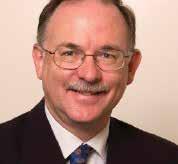Dr David Stanford – Improving Our Healthcare System With Queueing Theory
Dr David Stanford’s research at the University of Western Ontario involves applying the mathematics of Queueing Theory to real-world problems in healthcare, such as emergency department wait times and organ donor priority lists.

To begin with, what motivated you to build a career in Queueing Theory?
My motivation for being interested in waiting times dates back to my time growing up in Montreal. During my secondary education, I commuted some 25 km to a Jesuit high school, crossing the St. Lawrence River each day. The bridges were always congested, and I kept thinking ‘What a waste of time!’ Later in university, there was a specific incident I’ll always remember: I queued for about an hour one day just to cash my monthly assignment-marking paycheque, which made me late for the next class. I remember thinking ‘There has to be a better way to do this’. When I arrived late to class, it was the introductory lecture of Queueing Theory! I was hooked then and there.
Your queueing methods utilise priority gain over time to balance wait time and importance. Could you explain, for us nonmathematicians, how your methods are able to determine the best rate of priority gain?
The field of Key Performance Indicators (KPIs) provides the key. The idea behind KPIs is that patients should commence treatment by a time point specific to their level of urgency or acuity so as to avoid adverse outcomes. Occasionally, due to randomness in how patients arrive (which usually cannot be controlled), a fraction of patients will miss their targets. It is the occurrence of these situations we seek to minimise, both in terms of their frequency of occurrence and the amount by which they miss the specified delay. An accumulating priority mechanism implicitly keeps track of how long such patients have waited, so that by adjusting the rates of priority accumulation, we can find the right fit so that we succeed in maximising compliance with the specified waiting time targets for each acuity level.
Of course, if a facility is understaffed, an accumulating priority queue cannot produce a miraculous solution. The healthcare field is full of people saying things like ‘Think outside of the box’ as if creativity alone were capable of making all the queues disappear. Rather, a sound grounding in waiting time principles is needed to discern when a creative solution can make a difference, and when it amounts to ‘rearranging the deck chairs’ on the proverbial Titanic.
Why do you think that methods such as these, which are fairly well established in telecommunications, are only now being examined for use in healthcare?
That’s an excellent question. In Canada, and I think in most countries still, no training is given to doctors and other healthcare professionals on waiting times and queues, and their mathematical foundations. That is a critical mistake: in my view, all such professionals should have some idea as to the common physical phenomena that apply to all situations where people arrive at random for a capacitated service. Instead, we have all these smart individuals who have no training on something most are likely to have to deal with on a daily basis! As a result, people tend to think ‘It’s a queue; how hard could that be?’ when in fact understanding the consequences of workload, variability in arrival and treatment times, in the pooling of resources and in prioritisation is key to achieving a suitable solution. In short, we need to see a formal exposure of all healthcare professionals for whom access is a responsibility to queueing principles during their training, if we are to hope to see the types of benefits in the healthcare field that have been applied in telecom for the past hundred years.
You have mentioned that queue surges can be reduced by ‘pooling’ resources. How easily can this be applied to fields such as healthcare, where hospital locations have relatively ‘local’ catchment areas?
This is a matter of balance that requires a team-based approach to resolve. I am not a specialist in the agglomeration of regional healthcare facilities, but there is no need for me or any other queueing theorist to play that role. Healthcare professionals equipped with the right skill set, or even better, a teambased approach that includes a quantitative specialist (such as an industrial engineer, an operations researcher, a statistician or similar analytics professional) is key to determining that balance.
Where would you like to take your research from here? Have you a ‘dream’ subject, as it were?
It may sound silly, but I feel I have really found a niche in the area of KPIs and the use of the Accumulating Priority Queue (APQ) method to resolve them. There remains a wealth of aspects of the APQ still to be explored, relating to such things as the ‘affine’ case in which patients start with a base level of priority credit that depends upon their acuity, which then accumulates further from that point.
I’m also particularly interested in access as it applies to Emergency Medicine, whether you can it A&E, ED, or ER, and in transplantation wait times. I may not be able to heal patients as my father did, and as my brother and niece continue to do. But I hope I can continue to work with teams of medical professionals interested in applying queueing theory principles to heal healthcare systems. THAT is my dream!
TAKING NUMBERS AND GETTING THEM IN LINE
Medical treatment is overused and under-budgeted, leading to long wait times for those in need. How do we make these queues shorter and fairer? With the help of Queueing Theory, naturally.

It’s early morning; you’re on the way to work and want to pick up some coffee. Walk into the store, stand in line, and wait… and wait… The day has barely started and already you are frustrated and annoyed, all because of a simple queue on the way to get a coffee. Now think how much worse it would be if you were stuck in an interminable line and waiting for something really important – somewhere such as the emergency room of the local hospital.
Waiting times at a hospital are naturally more important than those at a café, but they both come down to some general rules which occur whenever people are lining up and queueing for something. The most basic of these is the underlying disconnect between how often people join the queue, and how often they leave. People arrive in a chaotic manner, with quiet lulls broken up by groups of customers – think of a train-station café with bursts of activity as a carriage of caffeine-starved bankers arrive. But they will leave the queue at a defined, regular rate – the barista from said café can only make two coffees per minute. The mixture of chaotic arrivals versus regulated departures almost guarantees that queues will occur.
Chaos is come again
The queueing problem becomes even more difficult when we move from cafes to hospitals. Emergency rooms need to prioritise patient treatments based on the urgency of their symptoms, a problem not shared by café owners (a heart attack will be treated before a broken finger, but the cappuccino does not need priority over the latte). To do this, emergency rooms will use a triage system, splitting patients into priority classes based on their need – patients in these groups must then be treated within a set period of time. In Canada, for example, patients are categorised as Resuscitation (treat them right now), Emergency (treat within 15min), Urgent (30min), Less Urgent (1h) and Not Urgent (2h).
‘I hope I can continue to work with teams of medical professionals interested in applying queueing theory principles to heal healthcare systems. THAT is my dream!’
Having ranked and categorised incoming patients, the challenge then is to determine the order in which they should be treated. Many hospitals use a simple ranking system: if a patient with higher priority comes in, they are treated first. This is excellent for critical cases but can be difficult for a patient with a ‘less urgent’ problem, who can be kept waiting for hours as new arrivals take their place in the line. In a sufficiently busy hospital, a less-urgent case can end up waiting for half a day before there is enough of a lull to let them reach the head of the queue.
So how can we solve this problem? One approach is to mix waiting time and importance. In this situation, every patient comes in and begins accumulating a figurative ‘priority score’. This score goes up with time, at a rate which is dependent on the classification of the patient. Broken arm? Your priority score will rise at a faster rate than the patient next to you with a strange rash. Every time a doctor is free, the waiting patient with the highest priority score will be admitted for treatment. By mixing time spent and importance, this hybrid system makes overall waiting times fairer for every type of patient.
This type of approach has been long used in the telecommunications industry, allowing the transmission of large amounts of data in an orderly manner. It and other techniques stem from a vast field of research known as Queueing Theory (appropriately enough), which delves into the mathematics behind queues in cafes and telephone lines. Some of these insights have also been adapted for the field of medicine through the work of mathematicians such as Dr David Stanford, of the Department of Statistical and Actuarial Sciences at Western University, Canada. His work includes the development of hospital queueing systems, as in our previous example, but also touches on a number of other healthcare fields.
Blood hath bought blood
For example, he has worked on the relatively knotty problem of organ transplants. As with hospitals, organ transplants involve patients waiting in a queue for a limited supply of medical help, in this case organ donors. Such queues are often growing in length, thanks in part to a mismatch between the numbers of donors and transplant patients. However, the system is more complicated than this, and can in fact be considered as a set of interlinked queues – each comprising a different blood type.
Blood types are caused by differences in the molecular sugars coating our red blood cells, and play an essential role in both blood transfusions and organ transplants. Combinations of genes give rise to several major groupings: Type O patients can donate to any recipient, but can themselves only receive Type O blood. Type A or Type B can receive their own blood types or Type O, but not AB. AB Patients can receive donations from any blood type, but can themselves only donate to other AB patients. Some combinations of organ donor and patient are thus simply impossible, and therein lies the problem.
How do you decide who gets a donor organ? Imagine a Type O liver, which can be transplanted into any patient. Should it be provided to the next patient on the list, regardless of their blood type? This is known as ABO-Compatible donation, in which patients are eligible for any donation which they can physically receive. Great for the A’s and B’s, but Type O patients now find that the only organ type they can actually receive is being used to keep other blood types alive – the consequence of which is that Type O patients now spend much longer waiting for a compatible donation than all other blood groups.
Alright then, what if we say that patients can only receive donations from those who have the same blood type as themselves? This is known as ABO-identical donation, and it solves the problems of O-Type patients waiting significantly longer than others. But of course, nothing is that easy – these systems thus bring in their own type of delays, this time those with less common blood types such as AB and B, who end up waiting for much longer thanks to their small pool of potential donors.
How do we resolve these two methods into a form that is fair to everyone concerned? Here the Queueing Theory mathematics utilised by Dr Stanford can come into play, and indeed the application of these techniques to organ donor queues is one of his research interests. Mathematical modelling and a solid dose of theory have allowed the development of a hybrid system, in which blood types are partially ‘pooled’ or joined together so that, for example, Type O can donate to Type B (but only occasionally), while Type A can only donate to Type AB (likewise, only occasionally), but no other cross-donations can occur. This links the less-common blood types to more common ones while keeping the groups relatively separate, thus allowing for fairer distribution of organs to needy patients than either of the previous methods.
Queues and Q’s
Both of these innovations utilise the power of Queueing Theory mathematics to develop more efficient ways of dealing with limited supplies – be they donor organs or doctor’s time. In a time characterised by aging populations and ever more expensive medical costs, these increases in efficiency are sorely needed to help keep healthcare budgets under control. Dr Stanford’s work is already being examined for implementation by Canadian healthcare authorities, and may eventually end up in hospitals around the country.
If hospitals give Queueing Theory its due, then perhaps one day the worst hospital queue will be the one by the coffee stand.
Meet the researcher

Professor David Stanford
Undergraduate Chair
Dept. of Statistical and Actuarial Sciences
University of Western Ontario, Canada
Professor Stanford obtained his PhD at Carleton University in 1981, and he now holds the Undergraduate Chair position at the Department of Statistical and Actuarial Sciences at the University of Western Ontario, Canada. His research there involves applying the mathematics of Queueing Theory to real-world problems in healthcare, such as emergency department wait times and organ donor priority lists.
CONTACT
T: (+1) 519 661 3612
W: http://www.stats.uwo.ca/faculty/stanford/
KEY COLLABORATORS
Professor Richard Caron
Na Li PhD
Maryam Mojalal MSc
Azaz Sharif PhD
Professor Peter Taylor
Associate Professor Ilze Ziedins
Dr Jon Dreyer
Dr Vivian McAlister
Dr David Savage
FUNDING
Professor Stanford’s research has been generously supported by Canada’s Natural Science and Engineering Research Council (NSERC), through its Discovery Grants program.
REFERENCES
DA Stanford, P Taylor, I Ziedins, Waiting time distributions in the accumulating priority queue, Queueing Systems, 2014, 77, 297–330.
DA Stanford, JM Lee, N Chandok, V McAlister, A queuing model to address waiting time inconsistency in solid-organ transplantation, Operations Research for Health Care, 2014, 3, 40–45.
Click HERE to view the research poster on ‘Addressing Waiting Time Inconsistencies due to ABO Status in Transplantation’
See below for Professor Stanford’s short tutorial ‘How Queueing Theory Can Improve Wait Times’: https://www.youtube.com/watch?v=SRqI_Ntrcnc (also available in French at https://www.youtube.com/ watch?v=KNLxLWV_IYM)

